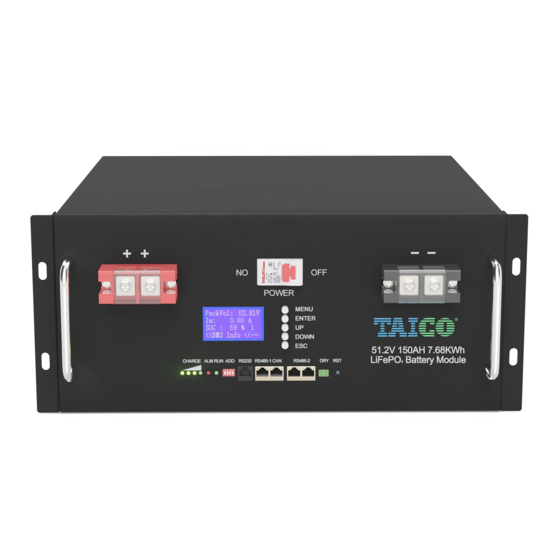
Table of Contents
Advertisement
Quick Links
Advertisement
Table of Contents

Summary of Contents for Taico TK4800
- Page 1 TK4800 (51.2V 100Ah) Lithium Iron Phosphate Battery User Manual...
-
Page 2: Table Of Contents
Directory Directory..................... 2 1. Notes.......................3 2. Introduction....................4 3. Characteristics..................4 4. Parameter Specifications..............5 4.1 Dimensions..................5 4.2 Battery Parameters.................5 4.3 Interface Definitions................6 5. LiFePO4 Battery Safety Operating Guidelines....... 9 5.1 Application Schematic..............9 5.2 Tools....................9 5.3 Security equipment................. 9 6 Installation.....................10 6.1 Installation location...............10 6.2 Installation.................. -
Page 3: Notes
1. NOTES Attention! (1)It is important and necessary to read the user manual carefully before installing or using the battery. The safety precautions mentioned in this manual do not represent all safety matters to be observed and only complement all safety precautions;... -
Page 4: Introduction
1.1.3 Wiring must be correct, do not mistake positive(+) and negative(-) cables, and ensure the external devices are not short-circuited; 1.1.4 Direct connection of batteries and AC power is prohibited; 1.1.5 Battery protection system is designed for 48V DC, no series connections allowed;... -
Page 5: Characteristics
3. Characteristics Environmental protection and pollution-free: the whole battery module using materials are non-toxic, pollution-free; long safety life: the core cathode material of battery module is made of LiFeOP4, good safety performance and long service life; Protection function: battery management system can protect battery module over discharge, over charge, over current and high / low temperature;... -
Page 6: Parameter Specifications
4. Parameter Specifications 4.1 Dimensions 4.2 Battery Parameters Parameters Project TK4800 (51.2V100Ah) Model Nominal voltage 51.2V 100Ah Nominal capacity 16 Series Combination mode Dimensions W×D×H (mm) 482×400×177 About 45KG Weight 43.2-58.4V Working voltage Charging voltage 56.8--58.4V 10A(The default charging current is greater Charging current limiting than 55A, and the current limiting is on)... -
Page 7: Interface Definitions
°C Discharge temperature range -20~60 Monitoring communications RS232, RS485, CAN Number of cycles 3000 Cycles Working environment Humidity :≤95; Altitude :≤4000 4.3 Interface Definitions 4.3.1 RET: Reset key When the BMS is dormant, press reset button for 3 seconds and release, the protection board will be activated, and LED indicator will light up in 0.5 seconds from “RUN"... - Page 8 4.3.2 RS485-2 With a dual RS485 interface, the default baud rate is bps.9600 can be expanded in parallel battery pack, communication interconnection. 4.3.3 RS232: Default baud rate bps .9600...
- Page 9 4.3.4 ADD : Address switch: four address switches, used to determine where the different communication address is. The lower position is off, which means 0. The upper position is on, which means 1. When the PACK is used in parallel, different addresses can be distinguished by the dial switch on the BMS.
- Page 10 Flash Flash Module Low Alarm Voltage Alway Elimin Maximum power Normal ation According to the electricity indicator LED flash (flash bright (power indicator maximum LED flash 2), overcharge Alway Flash alarm ALM no Alarm flicker bright Charg If there is no Alway Alwa Overcharge...
-
Page 11: Lifepo4 Battery Safety Operating Guidelines
Alwa Alwa Alwa Alwa Alwa Alwa Alwa Flash 75~100% bright bright bright bright bright bright bright ● running indicator Always bright Flash (flash 3) 5. LiFePO4 Battery Safety Operating Guidelines 5.1 Application Schematic 5.2 Tools The following tools are needed to install batteries Use insulated tools to prevent accidental electric shock or short circuit. -
Page 12: Installation
6. Installation 6.1 Installation location Ensure that the installation location meets the following conditions: 6.1.1 The area is completely waterproof. 6.1.2 The installation wall is flat. 6.1.3 No flammable and explosive items in nearing position 6.1.4 Ambient temperature is between 0°c and 50°C, the temperature and humidity remain constant. - Page 13 Note: When the battery is placed or pulled out of the rack, beware of the battery slipping out When multiple batteries are connected in parallel, as shown below: Note: when connecting equipment, the battery output positive and negative electrodes should be taken from the first group and the last group of batteries...
-
Page 14: Maintenance Precautions
7. Maintenance Precautions In the later stage of installation and use, the iron lithium battery can be simply maintained and inspected, because of its maintenance-free characteristics, the maintenance period can be extended, such as once every 3 months. Check whether the pole column and connection lines of LiFePO4 battery are loosed, damaged, deformed or corroded, and whether the battery case is damaged or deformed;... - Page 15 protection value. (2) Battery protection panel failure. Solution: the protection board will lock the state after entering the over-current state until the charger can be activated at the charging input end. 8.2 Discharge over-current protection ALM alarm indicator lights flicker, RUN operation indicator lights out. Cause analysis: (1) The load current is too large that exceeds the battery’s discharge protection value.

